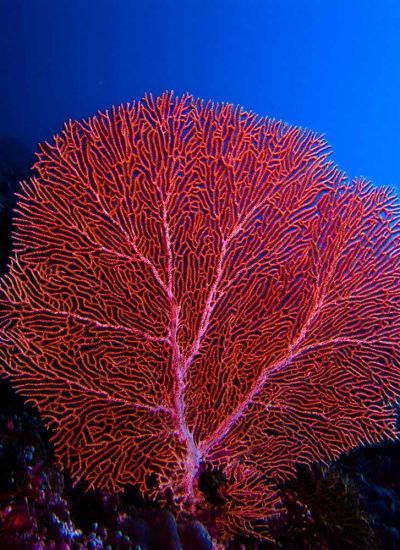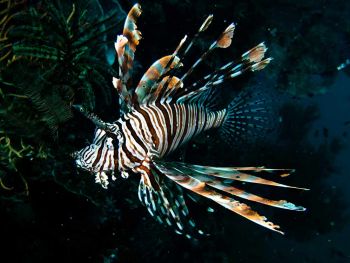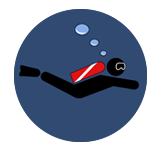 Gorgonian Sea fan Photo by Ilse Reijs & Jan Noud HuttenOf all the Koh Phi Phi diving sites, Loh Samah stands out by being in an excellent place and offering consistently-good diving conditions for all levels of divers, both during the day and at night. The dive site is easily found and Koh Lanta day trip and liveaboard boats can moor up in calm waters either for just the dive or all night. Depths go as far down as 25 metres, but there is rarely the need to do so on this colourful dive site with lots of healthy marine life. As already mentioned, Loh Samah Bay can be dived at night, not because of its position to favour boat moorings, but mainly due to the water conditions and marine life on show.
Gorgonian Sea fan Photo by Ilse Reijs & Jan Noud HuttenOf all the Koh Phi Phi diving sites, Loh Samah stands out by being in an excellent place and offering consistently-good diving conditions for all levels of divers, both during the day and at night. The dive site is easily found and Koh Lanta day trip and liveaboard boats can moor up in calm waters either for just the dive or all night. Depths go as far down as 25 metres, but there is rarely the need to do so on this colourful dive site with lots of healthy marine life. As already mentioned, Loh Samah Bay can be dived at night, not because of its position to favour boat moorings, but mainly due to the water conditions and marine life on show.
Underwater at Loh Samah Bay there are plenty of walls (many of which don’t reach the surface) and a gulley at 15m. It’s very easy for divers to maneuver around without getting confused or banging into anything or anyone. Generally, the sea conditions allow for easy diving and good visibility. The protection from Koh Phi Phi Lei means that creatures can thrive here instead of at some other Koh Phi Phi diving spots. There’s an abundance of reef fish, invertebrates, and even the odd shark or ray. Some of them can be seen resting in the day, and active at night. The rest are darting around or feeding during daylight hours, and hiding under rocks when it’s dark.
 Lionfish (Pterois) Photo by Ilse Reijs & Jan Noud HuttenNovice divers can dive here, accompanied by their dive instructor to depths of no more than 12 metres, they will see all kinds of animals, none of which are likely to do any harm. Lionfish (Pterois), stingrays and sea snakes may be venomous, but injuries to divers in Thailand are almost unheard of. Lionfish are beautiful and float around without a care in the world. Their venomous spines are to protect them from predators, while they wait for the opportunity to quickly swallow unsuspecting prey. The most common stingrays in this area are Blue-Spotted Stingrays (Neotrygon khulii) which can sometimes be seen at Loh Samah Bay, but normally on the flat and sandy bottom. Porcupine fish (Diodontidae) swim alone and slowly, and are always a pleasure to encounter. They blow up and expand just like Puffer Fish (Tetraodontidae) but it is unfair and unwise for divers to try to make them do so. Staying with bony fish, there are always some Parrotfish (Scarinae) and Moray Eels (Gymnothorax) here, too. The Parrotfish chomp on hard corals, which is then passed through their digestive systems and often seen coming out ‘the other end’ as fine sand. The Moray Eels spend their days sticking just their heads and necks out of holes and crevices in rocks. Although they look to be acting aggressively, their mouthing is just how they ensure water passes through their gills in order for them to breathe.
Lionfish (Pterois) Photo by Ilse Reijs & Jan Noud HuttenNovice divers can dive here, accompanied by their dive instructor to depths of no more than 12 metres, they will see all kinds of animals, none of which are likely to do any harm. Lionfish (Pterois), stingrays and sea snakes may be venomous, but injuries to divers in Thailand are almost unheard of. Lionfish are beautiful and float around without a care in the world. Their venomous spines are to protect them from predators, while they wait for the opportunity to quickly swallow unsuspecting prey. The most common stingrays in this area are Blue-Spotted Stingrays (Neotrygon khulii) which can sometimes be seen at Loh Samah Bay, but normally on the flat and sandy bottom. Porcupine fish (Diodontidae) swim alone and slowly, and are always a pleasure to encounter. They blow up and expand just like Puffer Fish (Tetraodontidae) but it is unfair and unwise for divers to try to make them do so. Staying with bony fish, there are always some Parrotfish (Scarinae) and Moray Eels (Gymnothorax) here, too. The Parrotfish chomp on hard corals, which is then passed through their digestive systems and often seen coming out ‘the other end’ as fine sand. The Moray Eels spend their days sticking just their heads and necks out of holes and crevices in rocks. Although they look to be acting aggressively, their mouthing is just how they ensure water passes through their gills in order for them to breathe.

